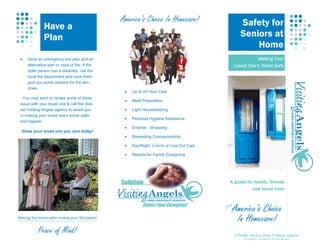Senior Safe Home
- 1. AmericaŌĆÖs Choice In Homecare! Safety for Have a Plan Seniors at Home ŌĆó Have an emergency exit plan and an Making Your alternative plan in case of fire. If the Loved OneŌĆÖs Home Safe older person has a disability, call the local fire department and have them give you some stickers for the win- dows. ŌĆó Up to 24 Hour Care You may want to review some of these ŌĆó Meal Preparation issue with your loved one & call the clos- est Visiting Angels agency to assist you ŌĆó Light Housekeeping in making your loved oneŌĆÖs home safer ŌĆó Personal Hygiene Assistance and happier. ŌĆó Errands - Shopping Show your loved one you care today! ŌĆó Rewarding Companionship ŌĆó Day/Night, Live-In or Live Out Care ŌĆó Respite for Family Caregiving Solution . . . A guide for family, friends and loved ones Select Your Caregiver! from AmericaŌĆÖs Choice Making the home safer makes your life easier! In Homecare! Peace of Mind! A Public Service from Visiting Angels┬« Each agency is privately owned and operated.
- 2. A Safe Home for Seniors Begins Here! A Guide For Family, Friends & Loved Ones To Making Home Life Safer. The purpose of this pamphlet is to Take a Walk Through The House ŌĆó Use slip-resistant decals or non-skid better educate and point out the mats in the tub or shower. everyday areas of concern that ŌĆó Keep all areas of the home, including each of us, as healthy adults, take hallways and stairs, well-lit, but free from ŌĆó Install grab bars in the bathtub and by for granted. glare. the toilet; be sure the screws go di- rectly into the wall studs, so they stay What may not be an obstacle to ŌĆó Remove scatter rugs, or attach a nonskid securely in place. you may be to your elder loved backing to them. one. ŌĆó Check to be sure that extension cords ŌĆó Reduce the risk of falling on uncarpeted are not overloaded & are clear of We will review areas of the home floors by ensuring that they are not slip- walkways. that should be addressed to better pery. Do not use any gloss polish. suit the mobility and agility limita- ŌĆó Install smoke detectors on every floor tions we can all experience as we ŌĆó Use night lights in the bedroom, hall- of the home and test them monthly. age. ways, kitchen and bathrooms. ŌĆó Destroy out-of-date medications and ŌĆó Keep the stove area in the kitchen free of those which are no longer being used. towels, paper towels, napkins, curtains, and other things that might catch fire. ŌĆó Place a telephone in the bedroom. Post emergency numbers by all tele- ŌĆó Remove all newspapers & magazines phones. from the kitchen counter areas. ŌĆó Keep space heaters away from flam- ŌĆó Keep a fire extinguisher in the kitchen, mable materials, and be sure the room and teach everyone of age to use it. is well ventilated. ŌĆó Inspect electrical cords for fraying or ŌĆó A three-pronged plug should be used cracking; be sure they are placed away in a three hole outlet, or an adapter from walking paths, but not under carpet should be used. or furniture, where they could present a fire hazard. ŌĆó Always turn off heating pads before an older person goes to sleep. ŌĆó Set the hot water temperature at 115 degrees or below on the water heater.

